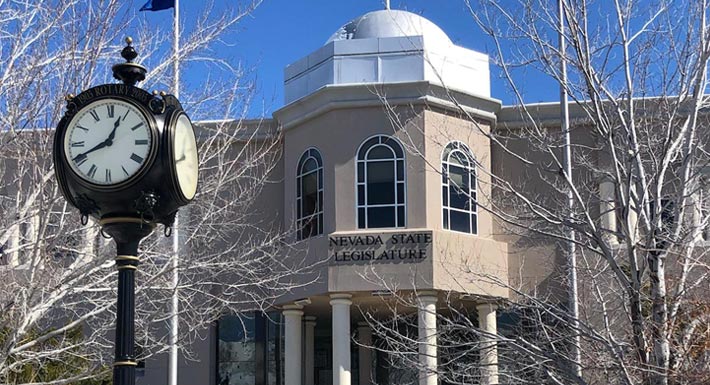The Senate Finance Committee and Assembly Ways and Means Committee held a joint meeting to hear Senate Bill 543, which would modernize Nevada’s education funding formula. Below is testimony provided by Board of School Trustee President Lola Brooks and Clark County School District (CCSD) Superintendent Jesus F. Jara in strong support of the proposed new funding formula:
Testimony provided by Trustee President Lola Brooks:
Senator Woodhouse, Assemblywoman Carlton, and members of the joint committee – my name is Lola Brooks, and I serve as the President of the Board of School Trustees for the Clark County School District.
The Board of Trustees approved a legislative platform in December, which included modernizing the state’s education funding formula as our top priority. We support AB 543 and see it as a step forward in addressing the education funding issues within the state. We feel that the community also supports this; their support was expressed when they elected a record number of candidates who ran on this and other education funding issues during the last election cycle.
One of the main roles of the Board is to give final approval for the district’s budget. Over the past few years, this has been a painful process which included more than $120 million in budget cuts and while it’s true that we’ve made due…it’s important that we are all very clear about the fact that we’ve made due at the expense of our students and our staff. Our class sizes are the largest in the nation. A reduction in staffing has led to unmanageable workloads and our inability to budget for raises continues to take a toll on staff morale.
At this juncture, you have an opportunity to move us in a different direction by modernizing the state’s education funding formula. There are several reasons why we feel this is a positive step forward.
We need to stabilize the amount of funding the state provides for education. SB 543 will require a State Education Fund that will increase by the rate of inflation or growth in the economy – whichever is greater.
We need to ensure that additional revenue goes to education as voters intended. Having the State Education Fund as a separate account will prevent new funds from supplanting existing funds.
We also need to give districts the opportunity to build an ending fund balance to ensure their financial stability.
While this legislation will not solve all of our funding issues, we are hopeful that it will be the first step to illustrate the state’s long-term commitment to adequately funding education. Thank you for your time today, for your work on this legislation, and for your ongoing leadership.
Testimony provided by Superintendent Jesus F. Jara:
Sen. Woodhouse, Assemblywoman Carlton and members of the joint committee: My name is Dr. Jesus Jara, and I am the superintendent of the Clark County School District, where we work every day to be the number one choice for our kids.
I want to start by thanking you all for the opportunity to speak at this historic event. While I have served the students of the Clark County School District for just less than a year, it was clear to me from when I first considered applying for this position that the 52-year-old education funding formula is a hindrance to equity and achievement.
So thank you, especially to Sens. Woodhouse and Denis, along with many others, who have worked countless hours on this enormous task.
I appreciate that you have outlined an implementation plan to hold harmless districts that might lose funding for several years, as we join as a state to work out details. It’s safe to say that many in Clark County are eager for this implementation to start immediately, but we also want to ensure that this plan will work for all kids across the state.
I want to add that I am sympathetic to districts that do not have the benefit of an economy of scale and face their own unique challenges. However, I hear a clear consensus among many that Clark County should no longer continue to subsidize school districts that have lower class sizes and higher ending fund balances than we do. It doesn’t make sense for our kids.
The Trustees and I have a five-year strategic plan to increase student achievement, reduce equity gaps and strengthen operations. I encourage you to view Focus: 2024 at ccsd.net. While we are excited about this plan, it’s difficult to guide major change knowing that we could be a few days away from bankruptcy, due to any major unforeseen expense.
If we want to prepare students for the jobs of tomorrow, we need adequate, stable funding today. Here’s why we are supporting this legislation:
First, we know we need to build trust throughout our community. This bill offers transparency to the public. We welcome the provisions that require school districts to report more about their budgets and administrative costs. Also, we welcome a formula that is easier for the public to understand.
Second, the new formula ensures that new money intended for K-12 public education stays with K-12 public education. I have spoken with thousands of educators, parents and community members in my 11 months in this position, and I can tell you they are sick of increasing funds for education and continuing to see budget cuts. Today we can start to put an end to the terrible cycle of budget cuts that has lead to our state having some of the largest class sizes in the nation.
Let me share a few numbers with you about our student needs today versus 1967, when the previous funding formula was created.
In 1967, CCSD had 62,944 students. We now have 320,000.
In 1967, we didn’t track the number of English Language Learners we served. Today, we serve 55,565.
In 1967, we didn’t track the number of students on Free and Reduced Lunch. Today, students on FRL make up 63.84% of our student population.
The number of students receiving special education services also has increased exponentially, now serving 39,709 students.
Here’s what is truly transformative about this formula: It will provide funding based on the individual needs of students. It provides weighted funds for students who need more support. It also adjusts funding based on the needs of smaller school districts, small schools, and areas where the cost of living for school employees is higher, such as in Clark County. This will be a game changer in Nevada.
I’d like to address some concerns that I have heard.
First, that SB 543 does not increase the overall amount of education funding. This is true – for now. That is why we are working with the sponsors of AB309 and SB545 to provide “bridge” funding to get us through this biennium. Nevada needs to modernize our funding formula before making significant new investments in education. Make no mistake, this is the right first step to fixing decades of chronic underfunding of public education in Nevada.
Second, I hear concerns that programs we know are working — such as the Zoom schools — might not continue. I want to thank legislators for Section 78 of this bill, which provides flexibility with student weights so we can maintain the programs that are proving successful. And I want to assure those with concerns that I will continue the successful structured programs currently funded with categorical dollars.
I will mention that one of our concerns is the implementation of weights for special education students. We have special education students who cost $50,000 a year to educate and students who require extra supports that might cost a few hundred a year. The vast majority of services provided to our children with special needs are through centrally provided programs, personnel and services. Therefore, it’s difficult to send the weighted funding directly to the schools serving our students without a significant change in the model that we and many other districts use to deliver the actual services for these students. We look forward to resolving this concern.
Finally, I have heard concerns about the provisions to protect district ending fund balances and wall off some funding from collective bargaining. This also will help stabilize our budget. As the chief executive of this district, I can tell you that something needs to happen fast to stabilize our budget. We have cut more than $120 million over the past two years. I will say it again – we cannot run a district with less than a week in reserves.
Our students, employees and community have struggled for far too long under a funding formula that doesn’t serve our needs today.
This proposal lays the groundwork for us to work together as a state to transform education. As the superintendent who represents more than 70 percent of the students in our state — students who deserve our absolute best — once again I want to say thank you.









